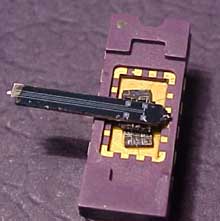Power and Electrical Engineering
This topic covers issues related to energy generation, conversion, transportation and consumption and how the industry is addressing the challenge of energy efficiency in general.
innovations-report provides in-depth and informative reports and articles on subjects ranging from wind energy, fuel cell technology, solar energy, geothermal energy, petroleum, gas, nuclear engineering, alternative energy and energy efficiency to fusion, hydrogen and superconductor technologies.

New conductor could provide answers for energy demand
Oak Ridge National Laboratory and 3M Company are hoping for powerful results from a project aimed at making transmitting electricity more efficient and reliable.
Researchers from 3M, working with ORNL, are developing a promising replacement conductor for conventional power lines that addresses the problem of power outages caused by sagging lines. Lines sag under the heat of high current loads. The replacement conductor also avoids the high cost and environmentally harmful effects of buildin

UPS Fleet Study Quantifies the Reliability, Low Emissions of CNG Trucks
A large study comparing trucks fueled by natural gas with others fueled by diesel found the natural gas vehicles produced only a quarter of the carbon monoxide emissions and half the oxides of nitrogen emissions of their diesel counterparts.
The study was conducted using package trucks operated by United Parcel Service (UPS), which has the nation’s largest private compressed natural gas (CNG) fleet. The study compared the operations, maintenance, performance, and emissions characteristics

Voice-command wheelchair developed at Coimbra University
A wheelchair robot developed by scientists at Coimbra University already has a prototype “capable of navigating without colliding with obstacles by commanded human voice”, as professor Urbano Nunes states, the person with joint responsibility, with professor Gabriel Pires, for the team of professors and students of the Electro-technical Engineering Department responsible for the project.
For the last five years this project has been developed and integrated in degree classes and pos

Tokamak fusion test reactor removal successfully completed
One of the world’s largest and most successful experimental fusion machines has been safely disassembled and cleared away. In September, staff at the U.S. Department of Energy’s (DOE) Princeton Plasma Physics Laboratory (PPPL) completed the dismantling and removal of the Tokamak Fusion Test Reactor (TFTR), which shut down in 1997 following 15 years of operation. During its experimental life, TFTR set records for fusion performance and made major contributions to the development of fusion as

Tiny atomic battery developed at Cornell could run for decades unattended, powering sensors or machines
While electronic circuits and nanomachines grow ever smaller, batteries to power them remain huge by comparison, as well as short-lived. But now Cornell University researchers have built a microscopic device that could supply power for decades to remote sensors or implantable medical devices by drawing energy from a radioactive isotope.
The device converts the energy stored in the radioactive material directly into motion. It could directly move the parts of a tiny machine or could generat

"Hydrogen and fuel cells – the bridge to sustainable energy?"
High Level Group for Hydrogen and Fuel Cell
Thank you Madam Vice President, and thank you again, (Ladies and) gentlemen for your attention.
Madam de Palacio has presented to you our concerns in the European Union over Global climate change, energy security and transport. We are committed to achieving sustainable development.
We re-stated our commitment in Johannesburg and are embarking on a comprehensive range of measures. This includes research on the most promisi